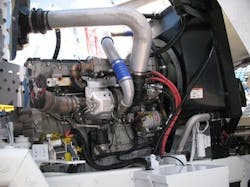Terex Advance offers EPA 2010-spec Cummins and Detroit diesels in its rear-engine, front-discharge mixers. But the few buying customers in the current market avoid the expensive products by buying glider-kitted trucks with older powertrains.
A dearth of orders for front-discharge concrete mixer trucks has caused Terex Advance to shut down its assembly line in Fort Wayne, Ind., and begin a reassessment of its manufacturing processes for when the market returns.
It’s also using the down time to redesign its trucks for better efficiency and maintainability.
On December 1, it permanently terminated 50 workers and support staff, but the company expects to rehire some of them when it resumes production later this year, said Dave Rinas, director of sales. New and improved trucks will probably be ready for introduction by this year’s third quarter, he said.
“It’s a business we thought was going to come back in 2011 and continue into 2012, but didn’t,” Rinas said of front-discharge mixers. “Now we don’t expect it to come back until 2014.”
Industry wide, the market for the rear-engine trucks is 90 percent off its 2006 peak of 12,000 a year, before the collapse of construction, he said. Terex Advance alone built and sold as many as 1,000 new trucks a year in boom times. Now most of its business is for glider kits and replacement parts for customers’ aging trucks.
Although Terex Advance displayed trucks at last year’s World of Concrete trade show in Las Vegas, it did not do so at this year’s show. Rinas discussed its plans at the booth of its corporate parent, Terex Roadbuilding.
Other manufacturers such as Kimbel Chassis, Indiana Phoenix and Phoenix’s new partners, Navistar International and Continental Mixer, gamely showed off front-discharge mixers at this year’s show. As in past years, Phoenix emphasized glider kits: a new truck with used, rebuilt or remanufactured powertrains and axles, which cost far less than new.
Navistar and other builders of conventional rear-discharge mixer chassis such as Freightliner, Mack, Kenworth, Peterbilt and Western Star showed vehicles, as did many suppliers of mixer bodies.
As usual at World of Concrete, there were scores of rear-discharge mixer trucks and other chassis toting large concrete pumpers inside and outside the Las Vegas Convention Center. Mixers are selling well into foreign countries, especially Mexico and South America, but are still slow in the U.S.
However, the construction market here is reviving, several supplier representatives said. They agreed that home building is still almost dead, and a resurrection there is what’s needed before the market for mixers and other construction trucks returns in force.
As at Indiana Phoenix, most of Terex Advance’s truck production recently has been for gliders. “We know there’s a market for them,” Rinas said of glider kits, “but it shouldn’t be 80 to 90 percent of production,” which it has been at the Fort Wayne plant. “It should be 10 to 20 percent.”
Frugal customers are keeping old trucks far longer than is wise, he said. Gliders often go out with used components that have poorer reliability than those that have been rebuilt or remanufactured, much less new.
Customer resistance to expensive, EPA 2010-legal engines is also responsible for static sales of new front-discharge mixers, and has driven sales of gliders that avoid them, Rinas and others said. Terex Advance has Cummins and Detroit diesels available, but has sold few if any.
Aging trucks need replacement parts, and that business is booming at Terex Advance, so it retained workers for its aftermarket activities. Also still there are a few key assembly line workers, including those who fabricate barrels and cabs to supply parts ordered by customers.
Engineers are discussing ways to improve the future assembly process, which has included three parallel truck lines and three perpendicular lines that fabricate frames, cabs and mixer barrels. Gear box drives and some hydraulic parts are purchased from suppliers.
“We know our labor costs have been high,” Rinas said, so manufacturing specialists are looking at adding robots to perform repetitive work. Other labor-intensive tasks might be redesigned for better efficiency.
In redesigning the Advance trucks, “we’re soliciting customer input,” Rinas said. “They want less weight without sacrificing durability”—an age-old desire.
Customers also want better ergonomics in the cabs and easier access to certain components. So product planners are considering a redesigned cab and wiring harness that’s sectional, so it can be replaced in pieces rather than by cutting into it.
Redesigned Advance mixers, then, are probably what will be built when production resumes in this year’s fourth quarter.





